Late Cretaceous K-rich rhyolitic crystal tuffs from the Chuduoqu area in Eastern Qiangtang subterrane: evidence for crustal thickening of the central Tibetan Plateau prior to India–Asia collision
2022-02-28YonggangSunBileLiFengyueSunQingfengDingJunlinDongYeQianYujinLiZhenYao
Yonggang Sun • Bile Li• Fengyue Sun • Qingfeng Ding • Junlin Dong •Ye Qian,4 • Yujin Li,4 • Zhen Yao
Received: 2 August 2021/Revised: 31 October 2021/Accepted: 25 November 2021/Published online: 17 January 2022
© The Author(s), under exclusive licence to Science Press and Institute of Geochemistry, CAS and Springer-Verlag GmbH Germany, part of Springer Nature 2021
Abstract In order to constrain whether the Lhasa–Qiangtang collision contributed to an early crustal thickening of the central Tibetan Plateau prior to the India–Asia collision, we present zircon LA–ICP–MS U–Pb ages, wholerock geochemistry, and zircon Hf isotopic compositions of the newly discovered rhyolitic crystal tuffs from the Chuduoqu area in the eastern Qiangtang subterrane, central Tibet. Zircon U–Pb dating suggests that the Chuduoqu rhyolitic crystal tuffs were emplaced at ca. 68 Ma. The Chuoduoqu rhyolitic crystal tuffs display high SiO2 and K2O, and low MgO, Cr, and Ni. Combined with their zircon Hf isotopic data, we suggest that they were derived from partial melting of the juvenile lower crust, and the magma underwent fractional crystallization and limited upper continental crustal assimilation during its evolution prior to eruption. They should be formed in a post-collisional environment related to lithospheric mantle delamination. The Chuduoqu rhyolitic crystal tuffs could provide important constraints on the Late Cretaceous crustal thickening of the central Tibetan Plateau caused by the Lhasa–Qiangtang collision.
Keywords Rhyolitic crystal tuffs · Late Cretaceous ·
1 Introduction
Generally, the Tibetan Plateau (TP) is considered to have formed in the early Cenozoic as a consequence of Indian and Asian continent collision along the Yarlung–Tsangpo suture zone (Fig. 1a; Nelson et al. 1996; Yin and Harrison 2000; Zhang et al. 2002; Chung et al. 2005; Quade et al.2007; Clark 2011), but recent studies have shown that the central TP was noticeably thickened prior to India–Asia collision, probably associated with the Lhasa–Qiangtang collision (Kapp et al. 2007; Li et al. 2013; Zhang et al.2014a; Chen et al. 2017a; Lu et al. 2019; Zhao et al.2020, 2021).
The Qiangtang Terrane is an important unit to understand the tectonic evolution of the TP. Widespread Late Cretaceous magmatic rocks in the Qiangtang Terrane provide important constraints on the geodynamic processes of the Lhasa–Qiangtang collision (Fig. 1b; Li et al. 2013;Chen et al. 2017a; He et al. 2019; Lu et al. 2019), especially with regard to early crustal thickening of the central TP(Kapp et al.2007).Many studies have been undertaken on these magmatic rocks, they mainly focused on Early Cretaceous(e.g.,Fan et al.2015a;Xu et al.2015;Hao et al.2016a) and early Late Cretaceous magmatism (e.g., Li et al. 2013; Wang et al. 2014; Chen et al. 2015; He et al.2018; Liu et al. 2018) in the central-northern Lhasa and western Qiangtang subterranes, and the latest Cretaceous magmatism in the western Qiangtang subterrane (Li et al.2013;Chen et al.2017a;He et al.2019).However,studies focused on the latest Cretaceous magmatism in the eastern Qiangtang subterrane are lacking(Lu et al.2019)(Table 1).Thus, our understanding of the tectonic evolution of the Lhasa–Qiangtang collision during the Late Cretaceous is incomplete.
In order to address the above problems, we present zircon LA-ICP-MS U–Pb ages, whole-rock geochemistry,and zircon Hf isotopic compositions of the newly discovered rhyolitic crystal tuffs from the Chuduoqu area in the eastern Qiangtang subterrane(Fig. 1b).These data provide important constraints on an early crustal thickening of the central TP caused by the Lhasa–Qiangtang collision, prior to the India–Asia collision.
2 Geological background and sample descriptions
From north to south,the TP comprises the Songpan-Ganze Terrane,the Qiangtang Terrane,the Lhasa Terrane,and the Himalayas (Fig. 1a; Yin and Harrison 2000) that are separated by the Jinshajiang, Bangong-Nujiang, and Yarlung-Tsangpo suture zones which represent relicts of Paleo-,Meso-, and Neo-Tethys oceans, respectively (Zhang et al.2012). The Longmucuo-Shuanghu suture zone divides the Qiangtang Terrane into western (or called southern) and eastern(or called northern)Qiangtang subterranes(Fig. 1a,b; Li 1987; Zhang et al. 2012; Fan et al. 2015b, 2017a),which is dominated by eclogites, blueschists, metasediments, marble, and gneisses (Li 1987; Li et al. 2008). The north and south margins of the Qiangtang Terrane are dominated by Upper Triassic-Upper Jurassic marine sedimentary rocks(Li et al.2013).Magmatic rocks exposed in the Qiangtang Terrane were mainly emplaced from Jurassic to Cenozoic time (Fig. 1b, c; Lu et al. 2019; Li et al.2020).According to recent geochronological data,they can be divided into three main magmatic episodes: Jurassic–Early Cretaceous(185–95 Ma,with a gap of 140–130 Ma),Late Cretaceous–Early Paleocene (90–64 Ma), and Eocene–Neogene (50–30 Ma) (Fig. 1b, c; Lu et al. 2019).
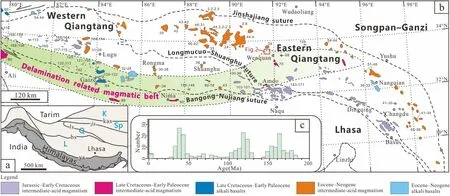
Fig. 1 a Simplified tectonic map of the Tibetan Plateau, western China. kas, Kunlun–Anyemaqen suture zone; js, Jinshajiang suture zone; ls,Longmucuo–Shuanghu suture zone; bs, Bangong-Nujiang suture zone; ys, Yarlung–Tsangpo suture zone; K, Qaidam Terrane; Sp, Songpan–Ganze Terrane; Q, Qiangtang Terrane; L, Lhasa Terrane. b Generalized geological map showing outcrops of Jurassic to Cenozoic magmatic rocks in the Qiangtang Terrane(modified after Lu et al.2019).c Age spectrum and histogram of the Jurassic to Cenozoic magmatic rocks in the Qiangtang Terrane (Lu et al. 2019)

Table 1 Summary of age data for the Late Cretaceous–Early Paleocene magmatic rocks in the central Tibetan Plateau

Table 1 continued
The Bangong-Nujiang suture zone extends >2000 km from west to east and has been divided into the western,middle, and eastern segments (Dewey et al. 1988). The suture zone is characterized by island arc fragments,Jurassic-Cretaceous flysch, me´lange, and scattered ophiolitic fragments, which represent the remnants of the Mesozoic Bangong-Nujiang Ocean (Fig. 1a; Bao et al.2007; Girardeau et al. 1985; Fan et al. 2017a; He et al.2018). The Lhasa Terrane is bounded to the north by the Bangong-Nujiang suture zone and to the south by the Yarlung–Tsangpo suture zone (Fig. 1a, b). The Lhasa Terrane can be divided into northern,central,and southern subterranes.The northern and central Lhasa subterranes are dominated by widespread Paleozoic–Mesozoic sedimentary rocks(Zhang et al.2012;Liu et al.2018).In addition,there are scattered outcrops of Early Cretaceous(135–110 Ma) and Late Cretaceous (95–64 Ma) magmatic rocks in the northern Lhasa subterrane(He et al.2019).The southern Lhasa subterrane is characterized by a widespread Early Jurassic-Middle Eocene Gangdese magmatic belt(Lee et al. 2009; Li et al. 2018; He et al. 2019).
The samples investigated in this study were collected from the Chuduoqu area, which is located in the eastern Qiangtang subterrane(Fig. 1b).It lies ~30 km northwest of Wenquan town (Fig. 1b). The strata exposed in the Chuduoqu area include the Middle Jurassic Buqu and Xiali formations,and Quaternary sediments(Fig. 2).The Middle Jurassic Buqu and Xiali formations are characterized by marine sedimentary rocks that are cut by several WNWtrending faults. The syenite porphyry intrudes into the Middle Jurassic Xiali Formation(Fig. 2).Locally,rhyolitic crystal tuffs overlie the Xiali Formation (J2x) across an unconformity (Fig. 2).
Rhyolitic crystal tuff samples were collected from surface exposures. The sample localities are shown in Fig. 2.Rhyolitic crystal tuff samples have the gray color of the fresh surface, show a tuffaceous texture and a massive structure, and mainly consist of crystal fragments (20%–25%) and volcanic ash (75%–80%) (Fig. 3). Phenocrysts are mainly composed of quartz, plagioclase, and biotite(Fig. 3).
3 Analytical methods
3.1 Zircon U–Pb dating
Zircon crystals were separated from the rhyolitic crystal tuff samples using standard heavy liquid and magnetic techniques, and then the zircon crystals were handpicked under a binocular microscope at the Shangyi Geologic Service, Langfang, China. All zircon crystals were examined by Cathode Luminescence (CL) imaging to reveal their internal structures.Laser ablation inductively coupled mass spectrometry (LA–ICP–MS) zircon U–Pb dating and trace element analyses were undertaken at Yanduzhongshi Geological Analysis Laboratories, Beijing. The laser ablation system is New Wave UP213 and ICP-MS is Aurora M90. Analyses were carried out with a beam diameter of 30 μm, ablation rate of 10 Hz, and energy density of 2.5 J/cm2. Detailed experimental testing procedures were described by Yuan et al. (2004). Helium was used as the carrier gas, and argon was used as compensation gas. Zircon 91,500 was used as the external standard for U–Pb dating. Trace element compositions of zircon crystals were quantified using SRM610 as an external standard,and Si was used as an internal standard(Liu et al.2010). Correction of common Pb was evaluated using themethod described by Andersen (2002). The ICP–MS DATECAL program was used to calculate isotopic data and elemental contents (Liu et al. 2008). Isoplot/Ex_ver3 was used to perform age calculations and generate Concordia diagrams (Ludwig 2003). Zircon U–Pb dating and zircon trace element compositions data are presented in Table S1 and Table S2 (electronic supplementary material), respectively.

Fig. 3 Photomicrographs for the rhyolitic crystal tuffs from the Chuduoqu area (left-cross polarized; right-plane polarized). Abbreviations:Pl = Plagioclase; Bt = Biotite;Qtz = Quartz
3.2 Whole-rock major and trace element analyses
The freshest parts of the rhyolitic crystal tuff samples with altered or weathered surfaces removed were selected for whole-rock geochemistry analysis before being crushed to 200 mesh. All whole-rock geochemistry analyses were conducted at the Key Laboratory of Mineral Resources Evaluation in Northeast Asia, Ministry of Land and Resources, Jilin University, Changchun, China. Major element compositions were determined by X-ray fluorescence (XRF) spectroscopy. Trace element compositions were determined by an Agilent 7500a ICP–MS. The analytical precision was better than 5% for major elements,and was better than 10%for trace elements,as estimated by using the international standards BHVO-2 and BCR-2,and national standards GBW07103 and GBW07104. The analytical results of major and trace elements are listed in Table S3 (electronic supplementary material).
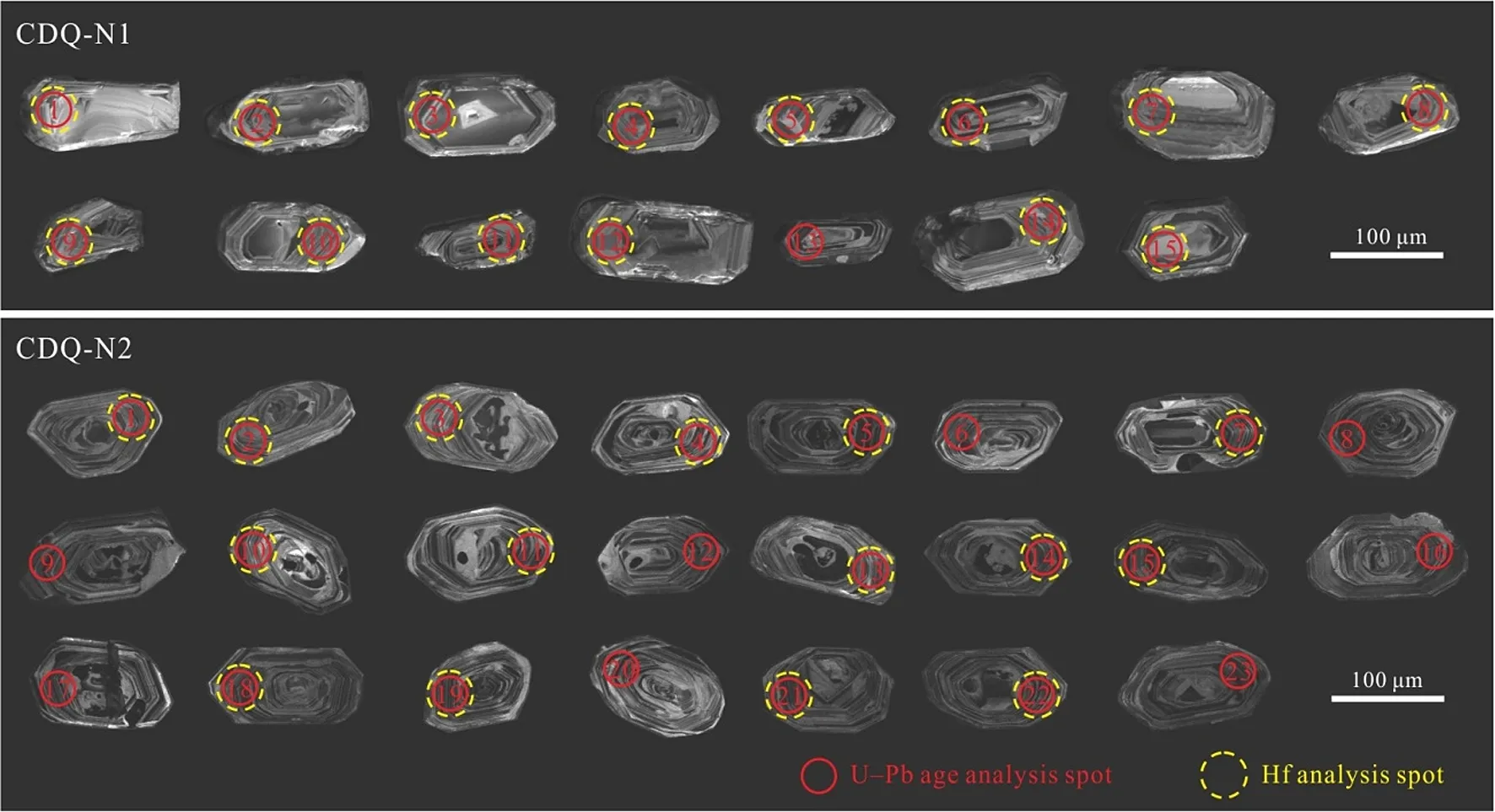
Fig.4 Cathode luminescence photomicrographs of zircon crystals for the rhyolitic crystal tuffs from the Chuduoqu area.Spot locations for LAICP-MS U–Pb (red circles) and Hf (yellow dashed circles) isotopic spot analyses are shown
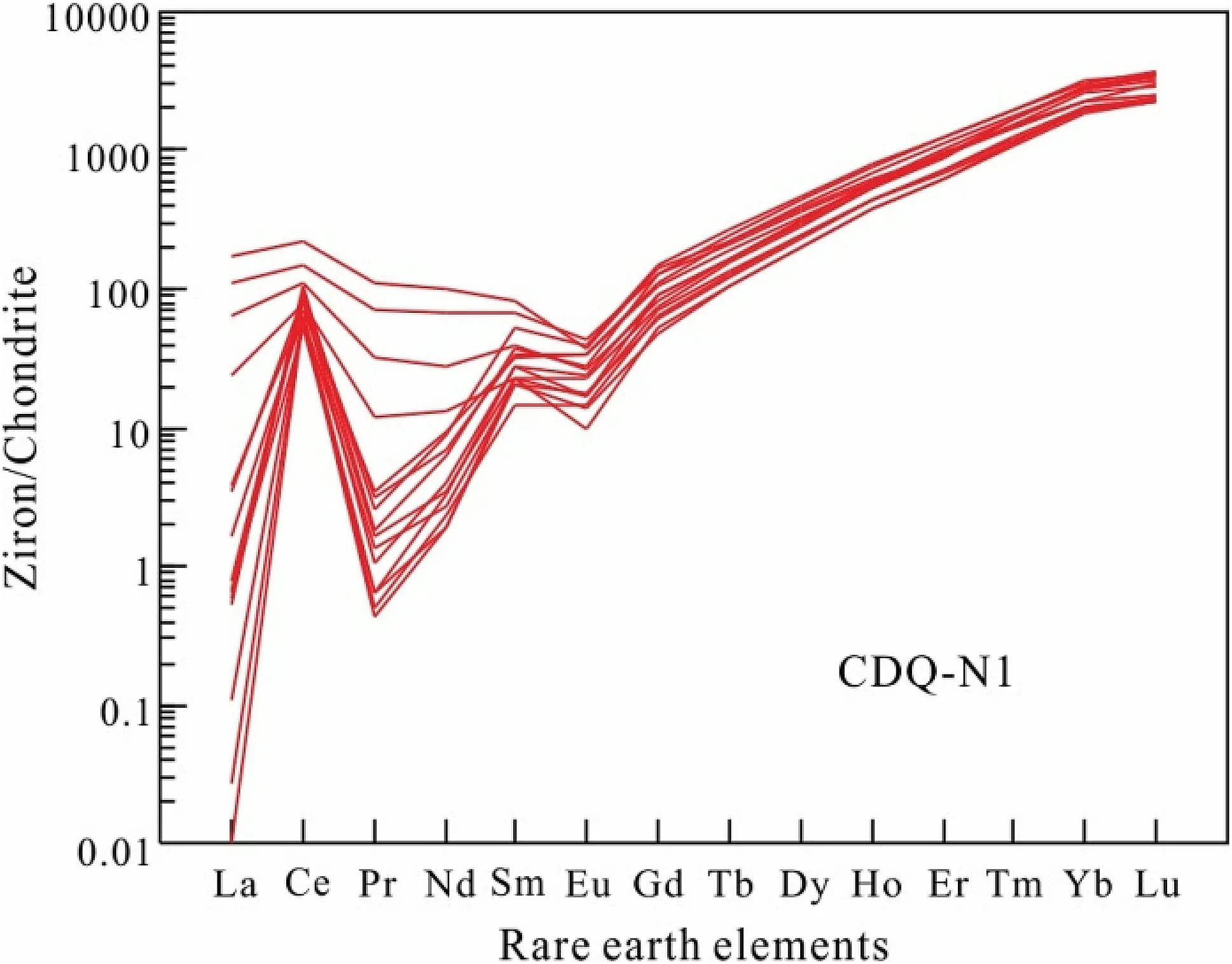
Fig. 5 Chondrite-normalized REE pattern of zircon crystals for the rhyolitic crystal tuffs from the Chuduoqu area.Normalized values for chondrite are from Taylor and McLennan (1985)
3.3 Zircon Hf isotopic analyses
Zircon Lu–Hf isotope analysis was carried out in-situ by using an NWR193 laser-ablation microprobe (Elemental Scientific Lasers LLC), attached to a Neptune multicollector ICP-MS at Yanduzhongshi Geological Analysis Laboratories,Beijing, China. The ablation spots for the Hf isotope analyses were located over the positions on the zircon crystals previously analyzed for zircon U–Pb dating.We adopted a beam diameter of 40 μm, ablation time of 31 s,ablation rate of 8 Hz,and energy density of 16 J/cm2.Detailed instrumental conditions, analytical procedures,and data acquisition techniques were comprehensively described by Wu et al.(2006).Zircon 91,500 and Plesovice were used as the reference standards during our routine analyses. Hf isotopic compositions data are listed in Table S4 (electronic supplementary material).
4 Analytical results
4.1 LA–ICP–MS zircon U–Pb ages
Zircon crystals from the rhyolitic crystal tuffs are generally columnar (Fig. 4). All analyzed zircon crystals were euhedral to subhedral.Their oscillatory growth zoning,the Th/U ratios (0.64–1.37), and pronounced positive Ce anomalies (e.g., CDQ-N1; Fig. 5) indicate a magmatic origin (Hoskin 2005). Fifteen zircon crystals from sample CDQ-N1 yielded206Pb/238U ages of 72–66 Ma and a weighted-mean age of 68.3 ± 0.7 Ma (MSWD = 1.19;n = 15) (Fig. 6a, b). Twenty-three zircon crystals from sample CDQ-N2 yielded206Pb/238U ages of 68–66 Ma and a weighted-mean age of 66.7 ± 0.3 Ma (MSWD = 0.77;n = 23) (Fig. 6c, d). These results together indicate that crystallization of the rhyolitic crystal tuffs occurred during the latest Cretaceous.
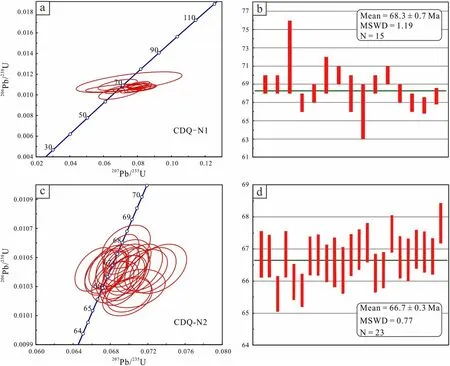
Fig. 6 a, c Zircon U–Pb concordia and b, d weighted mean age diagrams for the rhyolitic crystal tuffs from the Chuduoqu area

Fig.7 a Zr/TiO2*0.0001 versus SiO2(Winchester and Floyd 1977)and b Co versus Th(Hastie et al.2007)geochemical classification diagrams for the rhyolitic crystal tuffs from the Chuduoqu area
4.2 Whole-rock major and trace element compositions
The eleven analyzed rhyolitic crystal tuff samples display relatively high SiO2(63.25–75.72 wt%), Al2O3(11.59–16.20 wt%), and K2O (3.86–10.16 wt%), and low Na2O (0.02–0.16 wt%), TiO2(0.26–0.61 wt%), and MgO(0.07–0.59 wt%). All the Chuduoqu rhyolitic crystal tuff samples fall into the field of rhyolite to rhyodacite/dacite on the Zr/TiO2*0.0001 versus SiO2diagram (Fig. 7a), and show a high-K calc-alkaline to shoshonitic signature on the Co versus Th diagram (Fig. 7b; Hastie et al. 2007), suggesting a K-rich character.
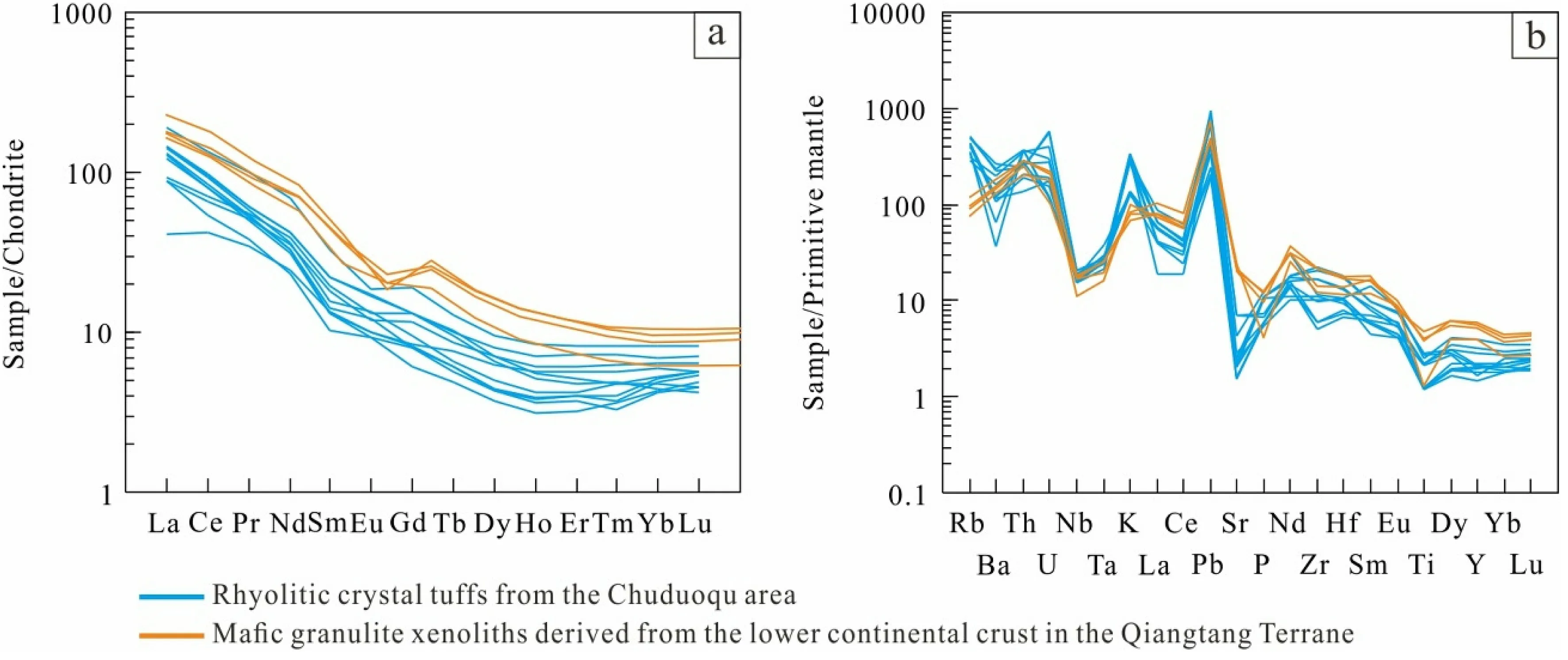
Fig. 8 a Chondrite-normalized REE patterns and b primitive mantle-normalized spider diagrams for the rhyolitic crystal tuffs from the Chuduoqu area.The chondrite values are from Boynton(1984),and the primitive mantle values are from Sun and McDonough(1989).The data for the mafic granulite xenoliths derived from the lower continental crust in the Qiangtang Terrane are from Lai et al. (2011)

Fig.9 a Plots of zircon U–Pb ages vs.εHf(t)values for the rhyolitic crystal tuffs from the Chuduoqu area.b Close-up view of the distribution of samples in a
The chondrite-normalized REE patterns of all the rhyolitic crystal tuff samples are slightly enriched in light rareearth elements (LREEs) with respect to heavy rare-earth elements (HREEs), and show weak negative Eu anomalies(Eu/Eu*= 0.73–1.14) (Fig. 8a). On the primitive mantlenormalized spider diagram (Fig. 8b), the rhyolitic crystal tuff samples are depleted in Nb, Ta, Ba, Sr, and Ti and enriched in Rb, Th, U, K, and Pb.
4.3 Zircon Hf isotopic compositions
Fourteen magmatic zircon crystals from sample CDQ-N1 were analyzed for Lu–Hf isotopes, yielding initial176Hf/177Hf ratios of 0.282720 to 0.282870 and positive dominated εHf(t)values of- 0.4 to 4.9,with corresponding TDM1and TDM2ages of 748 to 557 Ma and 1163 to 826 Ma, respectively (Fig. 9). Fifteen magmatic zircon crystals from sample CDQ-N2 were also analyzed for Lu–Hf isotopes, yielding initial176Hf/177Hf ratios of 0.282648 to 0.282838 and εHf(t) values of - 3.0 to 3.7, with corresponding TDM1and TDM2ages of 859 to 593 Ma and 1326 to 898 Ma, respectively (Fig. 9).
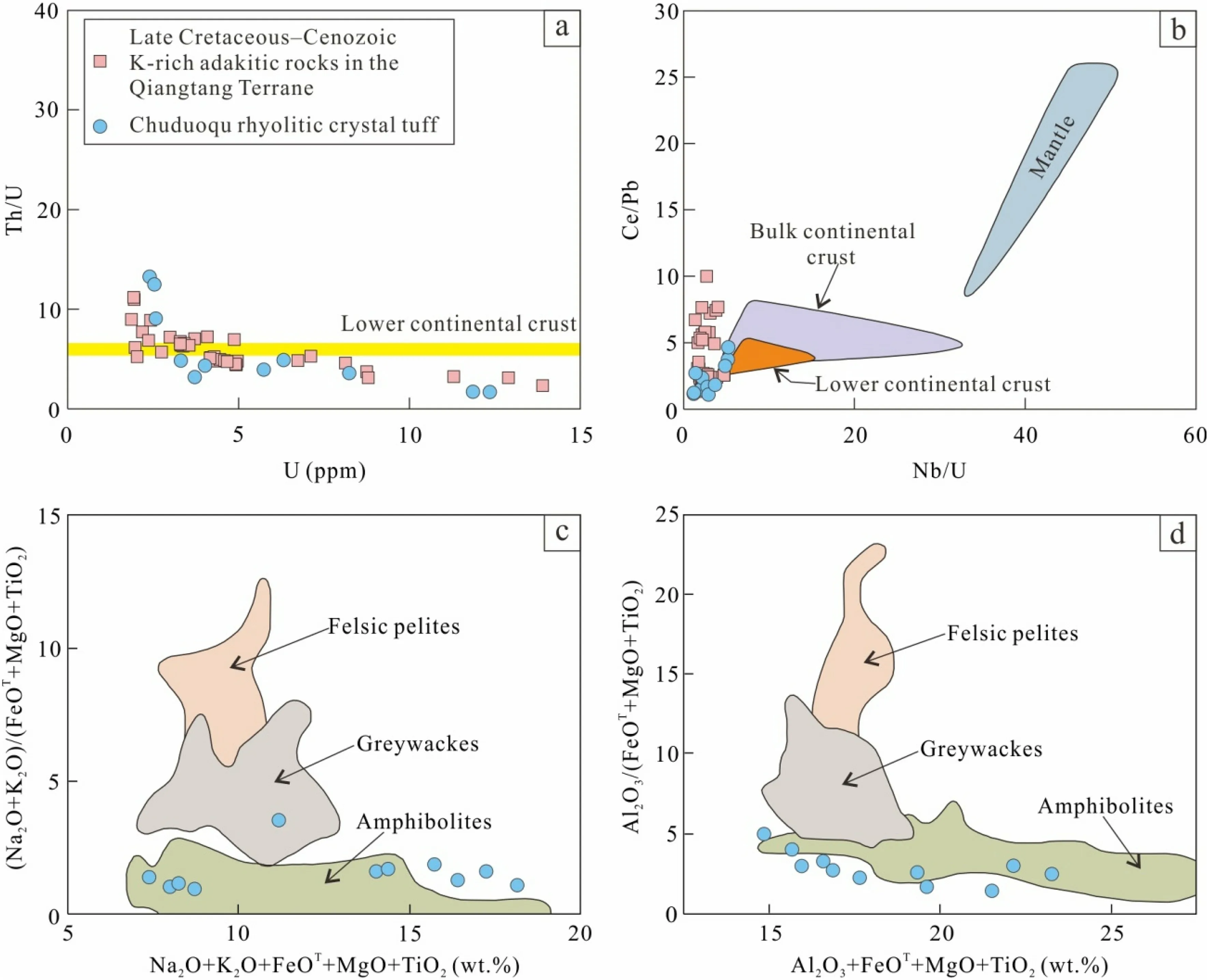
Fig. 10 a U versus Th/U, b Nb/U versus Ce/Pb, c (Na2O + K2O + FeOT + MgO + TiO2) versus (Na2O + K2O)/(FeOT + MgO + TiO2),and d(Al2O3 + FeOT + MgO + TiO2)versus Al2O3/(FeOT + MgO + TiO2)plots(Patin˜o Douce 1999)for the rhyolitic crystal tuffs from the Chuduoqu area. The average Th/U ratio (~6) of the lower continental crust is from Rudnick and Gao (2014). Data for Late Cretaceous–Cenozoic K-rich adakitic rocks in the Qiangtang Terrane are from Long et al. (2015), Zhang et al. (2015), and Lu et al. (2019)
5 Discussion
5.1 Origin of the rhyolitic crystal tuffs
In general,there are two main views on the origin of felsic volcanic rocks: (1) extensive fractional crystallization of mantle-derived magma (e.g., Civetta et al. 1998; Bonin 2004; Ronga et al. 2010), or(2) crustal anatexis caused by underplating of mantle-derived mafic magma (e.g., Kemp et al.2006;Zhu et al.2007,2011;Cesare et al.2009).The possibility that the Chuduoqu rhyolitic crystal tuffs were produced by fractional crystallization of mantle-derived magmas can be ruled out. Generally, large volumes of mafic magma are required for the generation of felsic magma. However, coeval mantle-derived mafic rocks in the region are minor (e.g., Bai et al. 2009; Li et al. 2013;Chen et al. 2017a; He et al. 2019). Consequently, we proposed that the magma of the Chuduoqu rhyolitic crystal tuffs formed from partial melting of the lower continental crust.Several lines of evidence support this possibility.(1)The Chuduoqu rhyolitic crystal tuffs display high SiO2(63.25–75.72 wt%) and K2O (3.86–10.16 wt%), low MgO(0.07–0.59 wt%), Cr (12.32–50.47 ppm), and Ni(5.62–28.64 ppm) concentrations, indicating a crustal source (Rudnick and Gao 2003). The REE and trace element patterns are similar to those of the mafic granulite xenoliths derived from the lower continental crust in the Qiangtang Terrane(Lai et al.2011;Fig. 8).(2)The Nb/Ta(8.05–13.03, average 11.47), Zr/Hf (26.38–47.01, average 37.72), Ce/Pb (1.09–4.66, average 2.29), and Nb/U(1.18–5.25,average 2.98)values of the Chuduoqu rhyolitic crystal tuffs are distinct from primitive mantle values(17.8,37,9,and 30,respectively;Sun and McDonough 1989),but similar to continental crust (11.4, 33, 4, and 12, respectively; Taylor and McLennan 1985), further strengthening its continental crustal affinity. (3) The geochemical characteristics of the Chuduoqu rhyolitic crystal tuffs are similar to those of Late Cretaceous–Cenozoic K-rich adakitic rocks in the Qiangtang Terrane(Fig. 10a,b),although they have obviously lower Sr contents and Sr/Y ratios than these K-rich adakitic rocks.These adakitic rocks were suggested to be derived from partial melting of the thickened lower continental crust (Long et al. 2015; Zhang et al. 2015; Lu et al. 2019). (4) The Chuduoqu rhyolitic crystal tuffs are high-K calc-alkaline to shoshonite series rocks (Fig. 7b).Experimental petrology studies show that hydrous melting of mafic rocks (e.g., amphibolites) can produce peraluminous melts with high contents of potassium (Rapp and Watson 1995; Chappell et al. 2012). The A/CNK ratios(1.12–1.94) of the Chuduoqu K-rich rhyolitic crystal tuffs are greater than 1.1, except for one (1.02). These characteristics are similar to those produced by hydrous melting of mafic rocks (e.g., amphibolites). Therefore, we believe that the Chuduoqu rhyolitic crystal tuffs were derived from partial melting of amphibolite-facies mafic crust. The majority of the Chuduoqu rhyolitic crystal tuff samples fall into the field of amphibolites also confirms this conclusion(Fig. 10c, d). (5) The zircon crystals from the Chuduoqu rhyolitic crystal tuffs display principally positive εHf(-t) values (0.1 to 4.9; Fig. 9) with TDM2ages of 1130–826 Ma (Table S4), suggesting that the primary magma was generated by partial melting of the juvenile basaltic lower crust that was accreted during the Meso–Neoproterozoic.
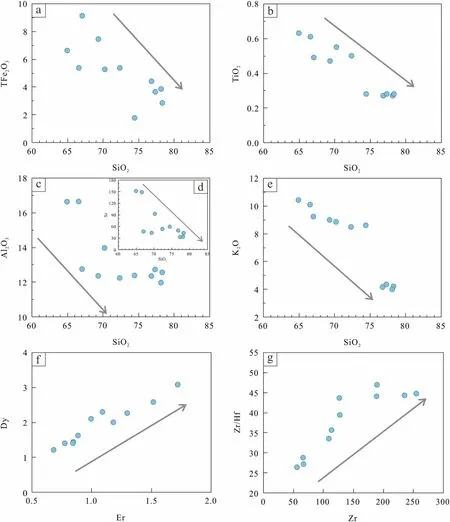
Fig. 11 Harker diagrams of selected major and trace elements for the rhyolitic crystal tuffs from the Chuduoqu area
5.2 Magmatic evolution
The trace element and Hf isotopic compositions(Figs. 8,9)of the Chuduoqu rhyolitic crystal tuffs are uniform, indicating a uniform magma source and the same magmatic evolution process. Two main pieces of evidence indicate that no significant upper continental crustal assimilation occurred during magma ascent. (1) No xenocrystic zircon crystals from the upper continental crust were found in the Chuduoqu rhyolitic crystal tuffs. (2) Each zircon crystal displays limited variation in the overall εHf(t) values(Table S4), indicating little addition of ancient upper continental crustal materials.
It has been suggested that fractional crystallization produces major variations in element compositions in igneous suites in any setting (Pearce and Peate 1995).Negative correlations between SiO2and TFe2O3and TiO2indicate the fractionation of Fe–Ti oxides (Fig. 11a, b).And the obvious depletions in Nb, Ta, and Ti may have resulted from the fractionation of Ti-bearing phases (e.g.,ilmenite,titanite,and rutile;Fig. 8b).The concentrations of Al2O3decrease with the increasing concentrations of SiO2(Fig. 11c), indicating the fractionation of plagioclase,consistent with the negative correlation between Sr and SiO2(Fig. 11d).The negative correlation between K2O and SiO2(Fig. 11e) may suggest the fractionation of K-feldspar. The depletions in Eu, Ba, and Sr also indicate the fractionation of plagioclase and K-feldspar (Fig. 8; Rapp et al. 2003). The positive correlation between Er and Dy suggests the fractionation of hornblende (Fig. 11f; Drummond et al. 1996). Moreover, the positive correlation between Zr/Hf ratios and Zr contents suggests the fractionation of zircon (Fig. 11g). Therefore, the above geochemical characteristics of the Chuduoqu rhyolitic crystal tuffs indicate that the magma underwent fractional crystallization during its evolution prior to eruption.
5.3 Geodynamic implications
The closure of the Bangong-Nujiang Ocean resulted in the Lhasa–Qiangtang collision. However, the closing time of the Bangong-Nujiang Ocean remains controversial. Some scholars suggested that the closure of the Bangong-Nujiang Ocean happened during Late Jurassic–Early Cretaceous(Girardeau et al.1985;Yin and Harrison 2000;Kapp et al.2005; Leier et al. 2007), whereas other researchers suggested that the Bangong-Nujiang Ocean was still open during Early Cretaceous and did not close until the late Early Cretaceous (Fan et al. 2014, 2015a, 2017b; Zhang et al.2014a;Xu et al.2015;Liu et al.2017b).To date,it is widely accepted that the northward subduction of the Bangong-Nujiang Ocean underneath the Qiangtang Terrane occurred (Yin and Harrison 2000; Guynn et al. 2006;Fan et al. 2018), but the existence of a southward subduction beneath the Lhasa Terrane is controversial (Zhu et al. 2015, 2016; Liu et al. 2020).
Jurassic–Early Cretaceous (ca. 170–100 Ma, with a magmatic gap of 140–130 Ma)continental arc magmatism and associated porphyry deposits developed in the western Qiangtang subterrane(Zhang et al.2012;Li et al.2017;Liu et al. 2017a). They were interpreted to result from the northward subduction of the Bangong-Nujiang Ocean(Fig. 13a; Li et al. 2014b, c; Hao et al. 2016b; Liu et al.2017a,b,c;Zhang et al.2017).The apparent magmatic gap of 140–130 Ma has been proposed to be a result of flat subduction of the Bangong-Nujiang Ocean(Li et al.2014b;Liu et al. 2017a, b, c; Zhang et al. 2017; Hao et al. 2019).Studies on ophiolites (Zhang et al. 2012; Liu et al. 2014;Xu et al. 2015; Wang et al. 2016), Late Jurassic–Middle Cretaceous marine flysch sediments(Fan et al.2015a),and Early Cretaceous radiolarians (Baxter et al. 2009) indicate that the Lhasa–Qiangtang collision likely happened at ca.100 Ma. The collisional environment is also supported by the following evidence. (1) The marine strata was unconformably overlain by the Jingzhushan Formation molasses(ca. 100–93 Ma; Kapp et al. 2007), suggesting that the transition from the marine environment to the continental environment is likely to occur during 100–93 Ma. (2) The angular unconformity between the continental Abushan Formation (102–96 Ma) and the underlying marine sediments could mark the collision between the Qiangtang and Lhasa terranes (Kapp et al. 2005; Li et al. 2010). Consequently, we tend to think that the Bangong-Nujiang Ocean closed during the late Early Cretaceous to early Late Cretaceous.The initial Lhasa–Qiangtang collision occurred at ca. 100 Ma (Kapp et al. 2007), sedimentary and structural analyses around the Bangong-Nujiang suture zone indicate that at this time the central TP had underwent significant crustal thickening (>40 km) and increase in elevation (~3–4 km above sea level) that were due to northward underthrusting of the Lhasa Terrane beneath the Qiangtang Terrane along the Bangong-Nujiang suture zone and continued into the Late Cretaceous prior to India–Asia collision (Kapp et al. 2005, 2007; Volkmer et al. 2007).Paleomagnetic and geochronological studies on Cretaceous strata of the Qiangtang Terrane further indicate that the Lhasa–Qiangtang collision occurred after ca. 100 Ma,which caused crustal thickening of the central TP during the Late Cretaceous (Chen et al. 2017b). The Chuduoqu rhyolitic crystal tuff samples are depleted in HREEs(Fig. 8a),show high(La/Yb)Nratios(7.01–33.33),and lowY (6.79–17.64 ppm) and Yb (0.89–1.73 ppm) contents,suggesting that higher-pressure minerals enriched in HREEs(e.g.,garnet)remained in the residue of the magma source during the evolution of the magma (Selby et al.2000). The higher-pressure residual minerals could reflect entrapment at lower levels in the crust in a compressional environment,as well as eruption through a thickened crust(Kay et al. 1994). Therefore, the high La/Yb ratios of the magmatic rocks are best explained by a thickened garnetbearing (lower) crust (Kay et al. 1994; Haschke et al.2002).On the age vs.La/Yb ratios diagram(Fig. 12),there are large ranges in La/Yb ratios and thus the hypothesized crustal thickness during the same time period. This could be owing to complex petrogenetic processes, including fractional crystallization, magma mixing, and upper continental crustal assimilation (Chung et al. 2009). Even so,there is still a direct indication that the Late Cretaceous magmatic rocks (ca. 91–67 Ma) have higher La/Yb ratios than the Early Cretaceous volcanic rocks(ca.145–105 Ma)in the central TP (Fig. 12). The La/Yb ratios of the latest Cretaceous Chuduoqu rhyolitic crystal tuffs (ca. 67 Ma)are even higher than those of Late Cretaceous magmatic rocks (ca. 91–76 Ma) in the central TP (Fig. 12). The crustal thickness increased from ~30 km during Early Cretaceous to ~50 km in latest Cretaceous (ca. 67 Ma).These observations provide clear evidence for Late Cretaceous crustal thickening in the central TP that took place prior to the Cenozoic India–Asia collision. In addition,LateCretaceouspetrologicalandgeochemical characteristics also support Late Cretaceous crustal thickening in the central TP. The period of 100–95 Ma was a magmatic quiescent period (Fig. 1c). Due to the Lhasa–Qiangtang collision, significant crustal thickening and shortening along the Bangong-Nujiang suture zone occurred during this period(Fig. 13b;Kapp et al.2007;Volkmer et al.2007;Lu et al.2019).The development of a regional unconformity (Kapp et al. 2005; Li et al. 2010) and deposition of molasse in the Jingzhushan Formation(Kapp et al. 2007), which have been described above, occurred during this time interval. Furthermore, Late Cretaceous adakitic rocks (ca. 94–64 Ma; e.g., Yu et al. 2011; Zhang et al. 2014b; Chen et al. 2015; Sun et al. 2015; Yi et al.2018; Liu et al. 2019) and K-rich magmatic rocks (ca.90–68 Ma; e.g., Li et al. 2013; Wang et al. 2014; Chen et al. 2017a; He et al. 2019; Lu et al. 2019) in the central TP also provide evidence for an early crustal thickening in the central TP during Late Cretaceous(Table 1;Zhao et al.2008;Chen et al.2015; Zhang et al.2015;Liu et al.2019;Lu et al. 2019). These rocks, together with limited alkali basalts (ca. 65 Ma; e.g., Kapp et al. 2002) and K-rich rhyolitic crystal tuffs in this study, make up an E–Wtrending magmatic belt (ca. 95–64 Ma) which is adjacent to the Bangong-Nujiang suture zone (Fig. 1b), which are thought to have evolved in the same tectonic setting (Lu et al. 2019).

Fig. 12 Age versus La/Yb ratios diagram for Late Cretaceous Chuduoqu rhyolitic crystal tuffs and other Cretaceous magmatic rocks.The crustal thickness correlation is inferred after Chung et al.(2009). Data sources: Early Cretaceous volcanic rocks are from Chen et al. (2017c) and references therein; Late Cretaceous magmatic rocks are from Li et al. (2013), Wang et al. (2014), Chen et al.(2015,2017a),Sun et al.(2015),and Lu et al. (2019)
The intense thickening of the lithosphere commonly leads to an increase in density, and the resulting gravitational instability could cause the thickening lithospherickeel to delaminate and sink into the asthenosphere(Houseman and Molnar 1997), leading to the upwelling of the asthenospheric mantle (Lustrino 2005). Therefore, it can be inferred that the central TP experienced delamination during Late Cretaceous (Li et al. 2013). In addition,these dispersed but small-volume Late Cretaceous high
Mg#adakitic rocks (ca. 94–88 Ma; Chen et al. 2015; Yi et al. 2018), K-rich magmatic rocks (ca. 90–68 Ma; Li et al. 2013; Wang et al. 2014; Chen et al. 2017a; He et al.2019; Lu et al. 2019), and Cu mineralization (ca.90–85 Ma; Song et al. 2014; Li et al. 2017) in the central TP were suggested to be genetically related to post-collisional lithospheric mantle delamination. Therefore, in the case of the Chuduoqu rhyolitic crystal tuffs, we contend that heat from the upwelling asthenosphere could have caused partial melting of the juvenile lower crust,resulting in the eruption of the Chuduoqu rhyolitic crystal tuffs(Fig. 13c). Late Cretaceous adakitic rocks, K-rich magmatic rocks(e.g.,the Chuduoqu rhyolitic crystal tuffs),and limited alkali basalts (Table 1) make up the delamination related magmatic belt in the central TP (Fig. 1b; Lu et al.2019).

Fig. 13 Schematic illustrations showing the geodynamic evolution of the central Tibetan Plateau during the Cretaceous period (see text for details)
6 Conclusions
(1) LA–ICP–MS zircon U–Pb dating shows that the Chuduoqu rhyolitic crystal tuffs were emplaced at ca. 68 Ma.
(2) The Chuduoqu rhyolitic crystal tuffs were derived from partial melting of the juvenile lower crust,fractional crystallization and limited upper continental crustal assimilation that occurred during magmatic evolution.
(3) The Chuduoqu rhyolitic crystal tuffs indicate that the central Tibetan Plateau experienced significant crustal thickening during Late Cretaceous, prior to India–Asia collision.
Supplementary InformationThe onlineversion contains supplementary material available at https://doi.org/10.1007/s11631-021-00516-9.
AcknowledgementsThis research was funded by the National Natural Science Foundation of China(41272093),the Geological Survey Project (12120114080901) of China Geological Survey, the Self-determined Foundation of Key Laboratory of Mineral Resources Evaluation in Northeast Asia, Ministry of Natural Resources (DBY-ZZ-19-04),the Shandong Provincial Natural Science Foundation of China(No. ZR2019PD017), the Natural Science Foundation of Liaoning Province (2020-BS-258), the Department of Education of Liaoning Province(LJ2020JCL010),and a Discipline Innovation Team Project of Liaoning Technical University (LNTU20TD-14).
Declarations
Conflict of interestWe declare no conflicts of interest in this study.
杂志排行
Acta Geochimica的其它文章
- Geochemistry of metasedimentary rocks of the Sonakhan and Mahakoshal greenstone belts, Central India: Implications for paleoweathering, paleogeography and mechanisms of greenstone belt development
- Geochemical analysis of multi-element in archaeological soils from Tappe Rivi in Northeast Iran
- First-principle study of Ba isotopic fractionation during ion exchange processes
- Pure forsterite in Nyiragongo lavas: evidence for subsolidus oxidation of volcanic rocks
- Petrogenesis and tectonic implications of the Early Cretaceous Dagushan adakitic porphyries in the Anshan area, North China Craton
- Zircon micro-texture and chemistry:an investigation of magmatic history and crystallization temperature of quartz potassic syenite from Iwo area, Southwestern Nigeria
